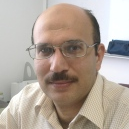International Journal of Intelligent Systems and Applications (IJISA)
IJISA Vol. 4, No. 2, 8 Mar. 2012
Cover page and Table of Contents: PDF (size: 421KB)
Design of Decentralized Fuzzy Logic Load Frequency Controller
Full Text (PDF, 421KB), PP.66-75
Views: 0 Downloads: 0
Author(s)
Index Terms
Load Frequency Control, Generation Rate Constraints, Conventional Integral Control, Fuzzy Logic Control
Abstract
This paper presents a novel approach for designing a decentralized controller for load frequency control of interconnected power areas. The proposed fuzzy logic load frequency controller (FLFC) has been designed to improve the dynamic performance of the frequency and tie line power under a sudden load change in the power areas. The effect of generation rate constraint (GRC) for both areas has been considered in the controller design. The proposed FLFC consists of two internal fuzzy logic controllers namely, the PD-like fuzzy logic controller and the PI-like fuzzy logic controller. The FLFC has been co-coordinated with the conventional integral controller. Time-domain simulations using MATALB/SIMULINK program has been performed to demonstrate the effectiveness of the proposed FLFC. The simulation results show that the proposed FLFC can provide good damping and reduce the overshoot even in the presence of the GRC.
Cite This Paper
K. A. Ellithy, K.A. El-Metwally, "Design of Decentralized Fuzzy Logic Load Frequency Controller", International Journal of Intelligent Systems and Applications(IJISA), vol.4, no.2, pp.66-75, 2012. DOI:10.5815/ijisa.2012.02.08
Reference
[1]Fosha, C.E. and Elgerd, O.I., The megawatt-frequency control problem: a New Approach via Optimal Control Theory, IEEE Trans. Power Apparatus and Systems, 1970, 89(4): 563-577.
[2]Kothari, D.P. and Nagrath, I.J. Modern Power System Analysis, 1st Edition, McGraw-Hill, New York, 2008.
[3]Kundur P. Power System Stability & Control, McGraw-Hill, New York, 1994.
[4]Wood, A. Power Generation, Operation and Control, 2nd Edition, Prentice-Hall. New York, 1996.
[5]Shayeghi H, Shayanfar HA, Jalili A. Load frequency control strategies: a state of-the-art survey for the researcher. Energy Conversion and Management, 2009, 50(2): 344–353
[6]Tan W. Decentralized load frequency controller analysis and tuning for multi-area power systems, Energy Conversion and Management , 2011,52(5): 2015–2023.
[7]Al-Badi, M., Awlad Thani, A. Al-Omeiri, B. and Ellithy, K.A. Comparative Study of Load Frequency Controller Design for Interconnected Power Systems, The Journal for Scientific Research-Science and Technology, Sultan Qaboos University,m 2002 , 7: 81-90.
[8]Chan, W.C. and Hsu, Y.Y., Automatic Generation Control of Interconnected Power Systems Using Variable Structure Controller. IEE Proc. on Generation, Transmission and Distribution Pt. C, 1981: 269-279.
[9]Feliach, A. , Optimal Decentralized Load Frequency Control, IEEE Trans. on Power Systems, 1987, 2: 379-386.
[10]Hiyama, T., Design of Decentralized Load Frequency Regulators for Interconnected Power Systems, IEE Proc., Pt C, 1982, 129 (1): 17-23.
[11]Hiyama, T. Optimization of Discrete-Type Load Frequency Regulator Considering Generation Rate Constraints, Proc. IEE, Pt. C, Generation, Transmission and Distribution, 1982, 129 (6): 285-289.
[12]Kothari, M.L., Nanda, J., Kothari, D.P. and Das, D., Discrete-Mode Automatic Generation Control of Two-Area Reheat Thermal System with New Area Control Error, IEEE Transactions on Power Systems, 1989, 4(2): 730-738.
[13]Oysal, Y. A Comparative Study of Adaptive Load Frequency Controller Designs in a Power System with Dynamic Neural Network Models, Energy Conversion and Management 2005, 46 (15-16): 2656-2668.
[14]Yang, T.C., Ding. and Yu, H. Decentralized power system load frequency control beyond the limit of diagonal dominance, Electric Power Energy System, 2002, 24(3): 173–184.
[15]Yang, T., Cimen, H. and Zhu, O. Decentralized Load-Frequency Controller Design Based on Structured Singular Values,” IEE Proc. on Generation, Transmission and Distribution, 1998, 145(1):.7-13.
[16]Ellithy, K.A. and Al-Naamany, A. A Hybrid Neuro-Fuzzy SVC Stabilizers for Power System Damping Improvement in the Presence of Load Parameters Uncertainty, International Journal of Electric Power Systems Research, 2000, 56(3): 211-223.
[17]El-Metwally, K.A. and Malik, O. Fuzzy logic power system stabilizer, IEE Proc. Generation, Transmission, and Distribution, 1995, 142(3): 277-281.
[18]El-Metwally, K.A., A Fuzzy Logic Based PID for Power System Stabilization, Journal of Electric machines and Power Systems , 2001, 29(7): 659-668.
[19]Momoh, J. Ma, X Tomsovic, K. Overview and literature survey of fuzzy set theory in power systems, IEEE Trans. on Power Systems, 1995, 10(3): 1676 – 1690.
[20]Passino, K. and Yurkovickh, S., H. Fuzzy Control, Addison Wesley Longman, Inc., 1998.
[21]Moon, Y.H., Lee, H.S., Sung, J.G., and Shin, K.B. Extended Integral Control for Load Frequency Control with the Consideration of Generation-rate Constraints, Electrical Power and Energy Systems , 2002, 24(4): 263-269.
[22]İlhan K. and Ertuğrul. C. Fuzzy logic controller in interconnected electrical power systems for load-frequency control, International Journal of Electrical Power & Energy Systems, 2005, 27(8): 542-549
[23]Tang, K.S, Man K.F., Chen G. and kwong S., An Optimal Fuzzy PID Controller, IEEE Trans. on Industrial Electronics , 2001, 48(4) 757-765.
[24]Pothiya, S., Ngamroo, I., Runggeratigul, S. and Tantaswadi, P. Design of Optimal Fuzzy Logic Based PI Controller using Multiple Tabu Search Algorithm for Load Frequency Control, Journal of Control, Automation, and Systems, 2006, 4(2): 155-164.
[25]Talaq, J. and Albasri F. Adaptive Fuzzy Gain Scheduling for Load Frequency Control, IEEE Trans. on Power Systems, 1999, 14(1): 145-151.
[26]Perez-Arriaga, I.J., Verghese, G.C. Schweppe, F.C. Selective Modal Analysis with Applications to Electric Power Systems. Part I: Heuristic Introduction. Part II: The Dynamic Stability Problem, IEEE Trans. On Power Apparatus and Systems, 1982, 101: 3117-3134.

